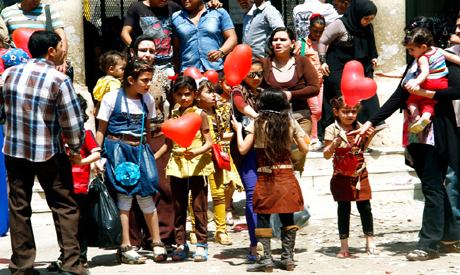
File Photo: Egyptians celebrate Sham El-Nessim (Mai Shaheen)
Sham El-Nessim, literally meaning ‘inhaling the fresh breeze’, is Egypt’s most celebrated ancient ritual.
People would colour their boiled eggs the day before and take it along with green food and salted fish and head out to the parks to enjoy the official celebration of Summertime.
Sham El-Nessim stood the test of time, because unlike many other feasts, it is related with the climate and geography of the Nile Valley.
Also due to the variety and revival of its social function. According to the Egyptian Archive of Folk Life and Folk Traditions, in Ancient Egypt, it marked the season Shmow (Spring), and it was also affiliated with the Osiris doctrine, reflecting the resurrection of life after death.
And despite the shift of the Official Religion of the state to Christianity then Islam, Sham El-Nesim held its status. For Sham El-Nessim is also affiliated with the agrarian, climate, and water cycle. Its official date is the 25th of the Coptic month Baramhat, which is usually a Monday. The Coptic calendar is based on agronomy and even has proverbs that match every season.
Also, the concept of resurrection, immortality, and life after death is a cross cutting theme of Osiris dogma, Christianity, and Islam. All of the above reasons made Sham El-Nessim stand the test of time.
The rituals of Sham El-Nessim start usually one week before the event.
Palm Sunday: Festivity starts off by making palm leaves into the form of a cross, heart, crowns, and rings. In most of Egypt, you will find the palm leaves interweaved with wheat, looking like a wheat basket. This is called the Wheat Doll, also known as Feriek Doll, it is usually hanged on house doors as an omen of a prosperous green year ahead.
Porridge Monday: Where some local communities make porridge.
Bloodletting Tuesday: Some local communities believed that it’s the best timing to get rid of the ‘bad winter blood’ by bloodletting.
Ayoub’s (Job’s) Wednesday: There is a folk belief that Prophet Ayoub (Job) was cured after God inspired him to scrub his body with Juniper. On that day, lots of people follow Ayoub’s ritual by scrubbing and taking a dip in running water.
Lentil Thursday: It’s the day when Egyptians cook lentils and preferably eat two eggs as a side meal, for eggs are known to prevent eye swollenness, which is usually affiliated with the coming days.
Sad/Long Friday: It’s defined as Sad by Copts and Long by Muslims, and on that day — in some governorates — lots of barren women pray for fertility.
Light Saturday: Everybody would wear Kuhl in their eyes to prevent eye diseases and also to enhance their sight and vision throughout the coming year.
Easter Sunday: It’s celebrated by Copts, and all Egyptians join the celebration and prepare for Sham El-Nessim by purchasing special food and also by sucking sugar cane. Also, some believe that putting some onions under the pillow will prevent the appearance of ‘Al-Shamama’ (The Sniffer), a mythological figure that roams around people while they are sleeping and sniffs them).
Sham El-Nessim Monday: One of the main rituals of that day, that dates back to the ancient Egyptians, is waking up at the crack of dawn and heading to the fields, gardens, and the banks of the river. This is affiliated with the greeting of Osiris, the deity of greenery, as he is revitalised once again. Folk beliefs reflect that it is healthy to start early and enjoy the fresh breeze of the day.
They eat green leaves like lettuce, green onions, malana, and boiled eggs and salted fish. Such food symbolises the revival of life and its positive impact on humans.
Short link: